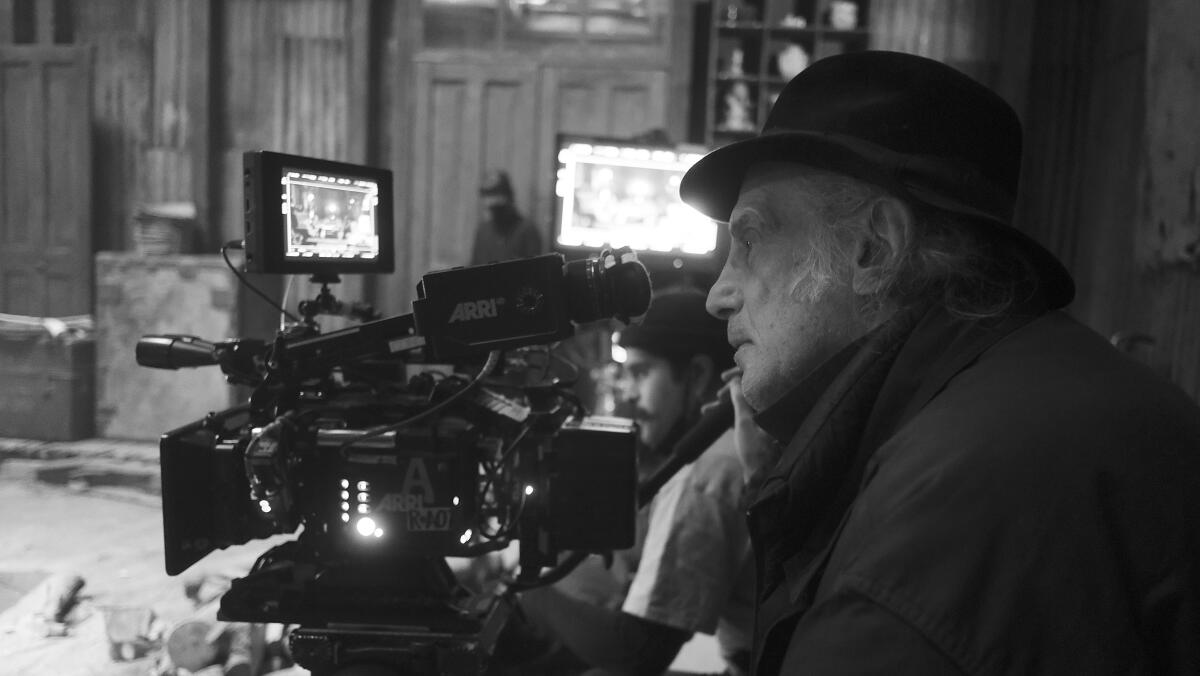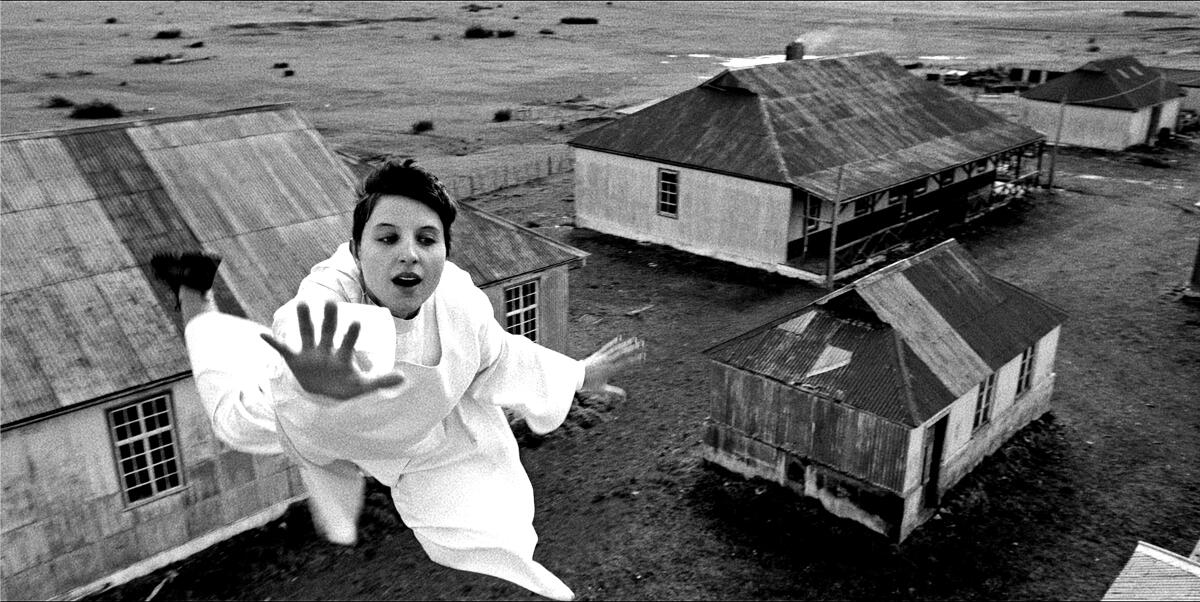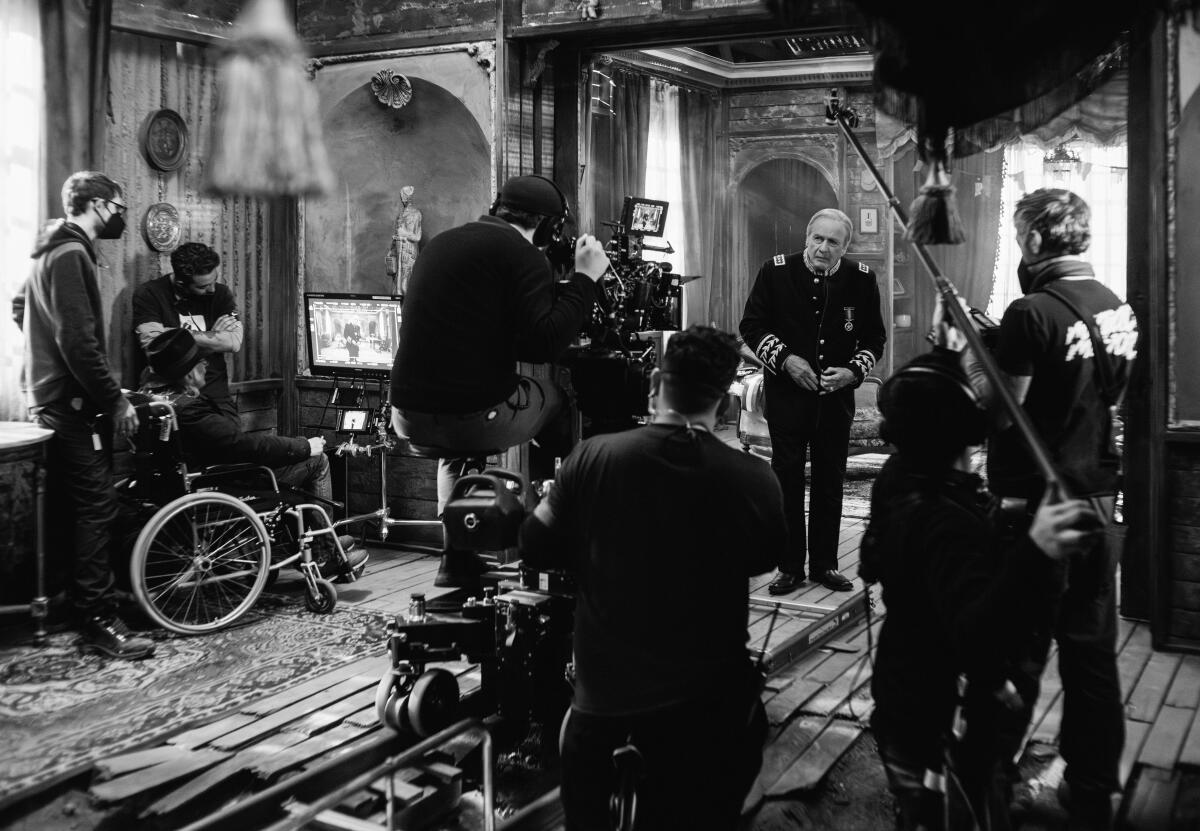A vampire movie that doesn’t suck: Shooting the black-and-white seductions of ‘El Conde’

Cinematographer Edward Lachman was starting to think he’d never get to work with director Pablo Larraín, an old acquaintance. But more than 15 years after their first meeting, “El Conde,” a satirical horror film that rethinks former Chilean President Augusto Pinochet (Jaime Vadell) as a vile, bloodsucking vampire, has become that occasion.
After his recent Oscar nomination (along with a coveted Silver Frog award at Camerimage, the prestigious cinematography festival), Lachman is being noticed — for good reason. From its opening frame, “El Conde” immerses viewers in a bygone black-and-white era dripping in shadowy German Expressionism. Lachman cites films such as F.W. Murnau’s “Nosferatu” (1922), Josef von Sternberg’s “Shanghai Express” (1932) and Carl Theodor Dreyer’s “Vampyr” (1932) as key influences on his visceral palette.
“Once Pablo wanted to go black-and-white and we’re dealing with the genre of vampire and gothic films, that became a touchstone to look back at these German and American expressionistic works,” the New Jersey born cinematographer, 75, tells The Envelope.

Pinochet came to power in 1973 and, until he was ousted in 1990, kidnapped, tortured and murdered thousands of Chileans. Larraín, known for his big-screen dramatizations of real-life public figures — Princess Diana in “Spencer” (2021) and Jacqueline Kennedy in “Jackie” (2016) — turns Pinochet into an undead evil living in a decrepit mansion in southern Chile for 250 years.
The terror that Pinochet inspired is a symbolic truth that generations of Chileans still grapple with today. “I didn’t want the images to take you out of what the story is really dealing with,” says Lachman. “It’s about internal pain. Yes, it’s metaphorical, who he is as a vampire, but that’s exactly what he was. He lived on these people’s hearts and minds that never got any retribution or healing. Pinochet died a wealthy man with impunity for his crimes against the society and culture he terrorized.”
In creating the look technically, the cinematographer asked camera manufacturer Arri to build a first-of-its-kind large-format camera with a monochromatic sensor. To his happy surprise, they were able to deliver the request several days before principal shooting began. Deepening the aesthetic, Lachman paired his newly acquired Arri Mini LF Monochrome camera with a set of customized Baltar lenses from the 1930s, as well as a set of vintage Harrison & Harrison black-and-white filters.
All of it rendered rich exteriors that felt foreboding and heavy even in daylight. Lachman also deployed another tool dubbed the EL Zone System, which he created. It’s based on a technique used by famed landscape photographer Ansel Adams as a way to evaluate exposure.
“This was the first time the system could be used on a film,” says Lachman. The toolkit gave him the powers of a painter with a brush, burnishing shadows and highlights to a fine level of detail.
Production shot in six different locations across Chile, with a farm in Patagonia serving as a key setting. Interiors of the house, corridors, basement and living room were shot first on built sets in Santiago. To light them, Lachman had to imagine what the exterior sunlight would look like months later when they eventually moved outside.

“When I went to scout the exteriors, they told me it would be winter with overcast light that could change very rapidly,” he recalls. “So I papered the windows and used curtains as diffusion with soft light coming in. But then at times I would cut holes in the diffusion to let highlights come through.” For the mansion’s central room, overhead fixtures provided the main source of lighting while set fixtures like chandeliers added texture and mood.
For the actors, Lachman chose to keep the darkness in their eyes. “Because we were lighting from the windows, I was concerned I would have to use an eye light,” he says. “Then I realized that these people are hiding from themselves and each other. That there’s a certain darkness that these characters live in even in daylight. So I embraced lighting that things are not being revealed about themselves. And what they are hiding from are the people that they persecuted.”
A Technocrane was used almost exclusively to find camera positions organically. “The camera had a certain fluidity to it,” says Lachman. Scenes depicting Pinochet flying were shot against bluescreen using a color camera and then converted to black-and-white. But for the flying sequence with Carmencita (Paula Luchsinger), a nun seduced by Pinochet’s vampire ways, the stunt was done practically, with the actor hung from wires connected to a crane.
“The film has a sense of contrast between light and dark, youth and age, and church and state,” says Lachman. “She’s learning to fly and this power mirrors those in the hierarchy of the church who supported Pinochet for their own power.”
Most vampire films deal with seduction and power, but via Lachman’s thoughtful shooting and Larraín’s political dimension, “El Conde” represents something deeper. Now having collaborated with the director, Lachman recognizes the suffering of the Chileans. “There was blood taken politically, socially and culturally from them,” he says. “ We have to be reminded over and over again of our own foils. The pain is eternal for them.”
More to Read
From the Oscars to the Emmys.
Get the Envelope newsletter for exclusive awards season coverage, behind-the-scenes stories from the Envelope podcast and columnist Glenn Whipp’s must-read analysis.
You may occasionally receive promotional content from the Los Angeles Times.







